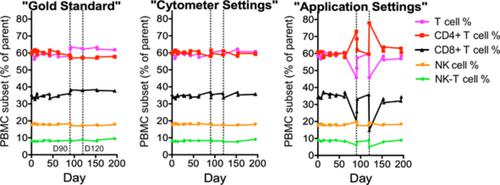当前位置:
X-MOL 学术
›
Cytom. Part A
›
论文详情
Our official English website, www.x-mol.net, welcomes your
feedback! (Note: you will need to create a separate account there.)
Application Settings versus Fixed Photomultiplier Tube Voltages for Optimal Cytometer Stability over Time, and Effect on Reusing a Compensation Matrix.
Cytometry Part A ( IF 2.5 ) Pub Date : 2020-04-21 , DOI: 10.1002/cyto.a.24013 Morten Nørgaard Andersen 1 , Anni Skovbo 1, 2 , Charlotte Christie Petersen 1, 2 , Marianne Hokland 1
Cytometry Part A ( IF 2.5 ) Pub Date : 2020-04-21 , DOI: 10.1002/cyto.a.24013 Morten Nørgaard Andersen 1 , Anni Skovbo 1, 2 , Charlotte Christie Petersen 1, 2 , Marianne Hokland 1
Affiliation

|
In flow cytometry, a compensation matrix is commonly reused over time, especially in clinical laboratories, to save time and reagents. However, generating a same‐day compensation matrix is considered the best practice by many experts. BD Biosciences developed Cytometer Setup and Tracking software to deliver proper instrument characterization, performance tracking, and stability. BD's “Application Settings” enable daily cytometer adjustments of photomultiplier tube (PMT) settings to correct for day‐to‐day variations in instrument performance. Here, we investigated if using Application Settings would improve data stability over time, including the impact on data stability when reusing a compensation matrix. We consecutively analyzed peripheral blood mononuclear cell (PBMC) aliquots from a single healthy donor together with 8‐peak Rainbow beads and daily compensation controls (22 runs in total over 6.5 months). We found larger variation within both PBMC subset quantifications and median fluorescence intensity (MFI) levels when using Application Settings (i.e., daily adjusted PMTs) compared to fixed PMT voltages (both with the same Day 0 compensation matrix applied). This larger variation was partly due to errors in compensation, but was also seen for Rainbow beads MFI data (not impacted by compensation), and thus likely produced by imprecise adjustments of PMTs by Applications Settings. Notably, the larger variation observed with Application Settings was most pronounced on a few days of the experiment with very large deviations, whereas on most days Application Settings and Fixed PMTs performed similar. The present results call for caution in using Application Settings in longitudinal studies, especially if also reusing a compensation matrix. In contrast, reusing a compensation matrix over time with fixed PMT voltages yielded stable results comparable with running same‐day compensation controls. © 2020 International Society for Advancement of Cytometry
中文翻译:

应用设置与固定光电倍增管电压的最佳细胞计稳定性随时间的变化,以及对重复使用补偿矩阵的影响。
在流式细胞术中,补偿矩阵通常会随时间重复使用,尤其是在临床实验室中,以节省时间和试剂。然而,生成当日薪酬矩阵被许多专家认为是最佳实践。BD Biosciences 开发了细胞仪设置和跟踪软件,以提供正确的仪器表征、性能跟踪和稳定性。BD 的“应用程序设置”允许对光电倍增管 (PMT) 设置进行日常细胞计数器调整,以校正仪器性能的日常变化。在这里,我们调查了使用应用程序设置是否会随着时间的推移提高数据稳定性,包括重用补偿矩阵时对数据稳定性的影响。我们连续分析了来自单个健康供体的外周血单核细胞 (PBMC) 等分试样以及 8 峰彩虹珠和每日补偿对照(6.5 个月内总共运行 22 次)。我们发现,与固定 PMT 电压(均应用相同的第 0 天补偿矩阵)相比,使用应用设置(即每日调整的 PMT)时,PBMC 子集量化和中值荧光强度 (MFI) 水平的变化更大。这种较大的变化部分是由于补偿错误,但也出现在 Rainbow 珠子 MFI 数据中(不受补偿影响),因此可能是由应用程序设置对 PMT 的不精确调整造成的。值得注意的是,应用设置观察到的较大变化在实验的几天内最为明显,偏差非常大,而在大多数日子里,应用程序设置和固定 PMT 的表现相似。目前的结果要求在纵向研究中使用应用程序设置时要谨慎,特别是如果还重用补偿矩阵。相比之下,随着时间的推移,在固定 PMT 电压下重复使用补偿矩阵会产生与运行当天补偿控制相当的稳定结果。© 2020 国际细胞计量学促进会
更新日期:2020-04-21
中文翻译:

应用设置与固定光电倍增管电压的最佳细胞计稳定性随时间的变化,以及对重复使用补偿矩阵的影响。
在流式细胞术中,补偿矩阵通常会随时间重复使用,尤其是在临床实验室中,以节省时间和试剂。然而,生成当日薪酬矩阵被许多专家认为是最佳实践。BD Biosciences 开发了细胞仪设置和跟踪软件,以提供正确的仪器表征、性能跟踪和稳定性。BD 的“应用程序设置”允许对光电倍增管 (PMT) 设置进行日常细胞计数器调整,以校正仪器性能的日常变化。在这里,我们调查了使用应用程序设置是否会随着时间的推移提高数据稳定性,包括重用补偿矩阵时对数据稳定性的影响。我们连续分析了来自单个健康供体的外周血单核细胞 (PBMC) 等分试样以及 8 峰彩虹珠和每日补偿对照(6.5 个月内总共运行 22 次)。我们发现,与固定 PMT 电压(均应用相同的第 0 天补偿矩阵)相比,使用应用设置(即每日调整的 PMT)时,PBMC 子集量化和中值荧光强度 (MFI) 水平的变化更大。这种较大的变化部分是由于补偿错误,但也出现在 Rainbow 珠子 MFI 数据中(不受补偿影响),因此可能是由应用程序设置对 PMT 的不精确调整造成的。值得注意的是,应用设置观察到的较大变化在实验的几天内最为明显,偏差非常大,而在大多数日子里,应用程序设置和固定 PMT 的表现相似。目前的结果要求在纵向研究中使用应用程序设置时要谨慎,特别是如果还重用补偿矩阵。相比之下,随着时间的推移,在固定 PMT 电压下重复使用补偿矩阵会产生与运行当天补偿控制相当的稳定结果。© 2020 国际细胞计量学促进会











































 京公网安备 11010802027423号
京公网安备 11010802027423号